Standing onstage at Boston’s Paradise Rock Club, 64-year-old Billy Zoom doesn’t look a day over 40. In his signature wide stance, he peers out over a sea of thrashing bodies with the vacant grin of a joker. Possibly for fear of blinding, he never once looks down at his sparkling Silver Jet as he shreds. The entire club, entranced by X’s beloved punk rock anthem “Los Angeles,” murmurs with cult-like enthusiasm, “She had to leave ... It felt sad, it felt sad, it felt sad.”
Just a few weeks earlier, not far from L.A., Zoom was in his Orange County shop, where he’s known in the industry as a jack-of-all-trades for his technical work building, repairing, and modifying tube amps—work he says he prefers to touring. “I hate that feeling right before I have to leave,” he says. “I usually don’t bother to read the itinerary or anything until a few days before so I don’t have to think about it.”
Nerves and X aside, this guy earned his stripes playing with legendary acts like Gene Vincent, Etta James, and Big Joe Turner—and in certain circles, he’s considered among the greatest players of all time. But some may not know that he spends the rest of his time tinkering with tubes in his workshop.
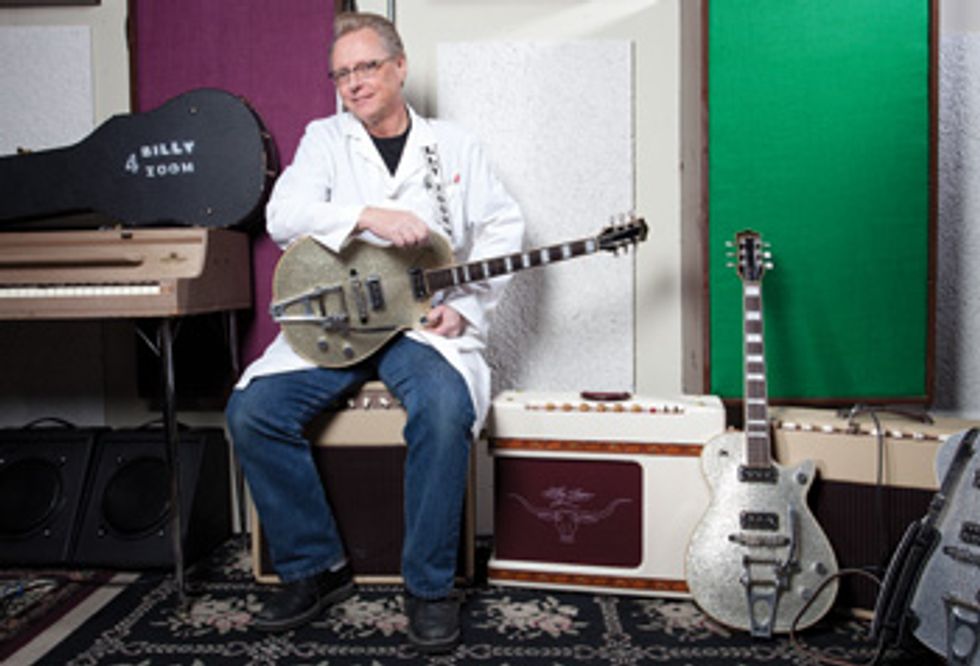
Billy Zoom holds his signature Gretsch Custom Shop Tribute Silver Jet model, which was part of a limited run that is now totally sold out. “Mike McCready from Pearl Jam got the last one,” Zoom says. Nearby are his special stereo model Silver Jet with TV Jones pickups, as well as a stereo amp he built. Photo by John Gilhooley
Most people know you as a guitar hero.
How did you get into building and modifying
amps?
I started getting into ham radio when I was
much younger. In 1958 I started building
kits and working with radio transmitters. I
was also playing guitar, but I had an acoustic.
In about ’62 I switched to electric and
had to have an amplifier. I started to realize
it was the same kind of stuff. The inside of
an amp made sense to me because I already
knew the radio stuff. I became the local
amp repair guy, and then in the late ’60s I
went to a vocational school for two years to
learn electronics. Basically it was training
to be a color TV technician, but it was a
really good background. It was only the last
semester that was television intense. I went
in knowing I was going to apply the skills
to working with sound. I usually kept the
poor teacher after class for an hour or two
every time, badgering him with questions
and bringing in amps.
And then you opened your first shop
in 1970?
Yeah, on the corner of Sunset Boulevard
and Vista Street in Hollywood. I do a fair
amount of general repair work to anything
with tubes, plus guitars, studio gear, and
then modifications and building my products.
I do it all. It’s kind of a mix.
And you’ve been in business ever since?
Pretty much, except for the years like ’88,
’85, when X was touring constantly and I
moved my shop to my house but was still
working in between tours.
X has been touring regularly again since
’98, right?
Yeah.
How do you go about balancing your
business with touring?
With great difficulty. I’m not here enough.
We’ve been really busy touring this year.
I also moved my shop to a bigger facility
between tours.
How does it feel leaving your business to
go on tour?
I hate going out. I get nervous about traveling
at the beginning of every tour. “What
did I forget? What didn’t I bring? What am
I gonna need that I’m not gonna have?”
That sort of thing. I have two of everything
and one stays packed. Once we’ve played a
show and I know I didn’t forget anything,
or I know what I forgot, then I’m okay.
How have your designs changed over the
past 40 years?
Well, like everyone I started out in the early
’70s just copying. The first amps I built for
sale were based on Fender 4x10 Bassmans,
and gradually I just started developing my
own circuits. Now I’m not copying anything.
What products are you currently offering?
The only thing in production right now is
the Little Kahuna, which is a reverberation
and tremolo unit that’s all tube. I still do
custom amps—one-offs and stuff. I can
really only put one thing in production
at a time. So I’ll do a run of a hundred of
something and then do a run of a hundred
of something else. I manage to make
enough to at least always have a couple of
amps in stock and some packed and ready
to go.
The Kahuna came out in 2009?
Kind of. We did the NAMM show in 2009
and showed it. I got started actually building
them at the beginning of 2010, but
then I had cancer surgery so I think I only
got 10 of them shipped before the surgery.
It was out of circulation for a few months
before I came back. Most of them have
been built since late 2010.
How many have you done?
Serial numbers are up to about 70.
And how did you come up with the design?
Well there was a Big Kahuna that was fancier.
It was too much trouble; I only made
a couple of those. But that’s why it’s called
the Little Kahuna. One day I got a sales flyer
from a tube supplier and they had reissued
6BM8s. I thought, “Gee, that’d make a good
reverb,” and I started tinkering with that and
the tremolo. There wasn’t anything like it on
the market. There were some cheesy tremolo
pedals and some bad reverb units, but there
wasn’t a good one in a single box.
Are you making them by yourself?
I have a company that’s making the raw
cabinets for the Kahunas now, but other
than that it’s all me, and I still have to finish
the cabinets myself.
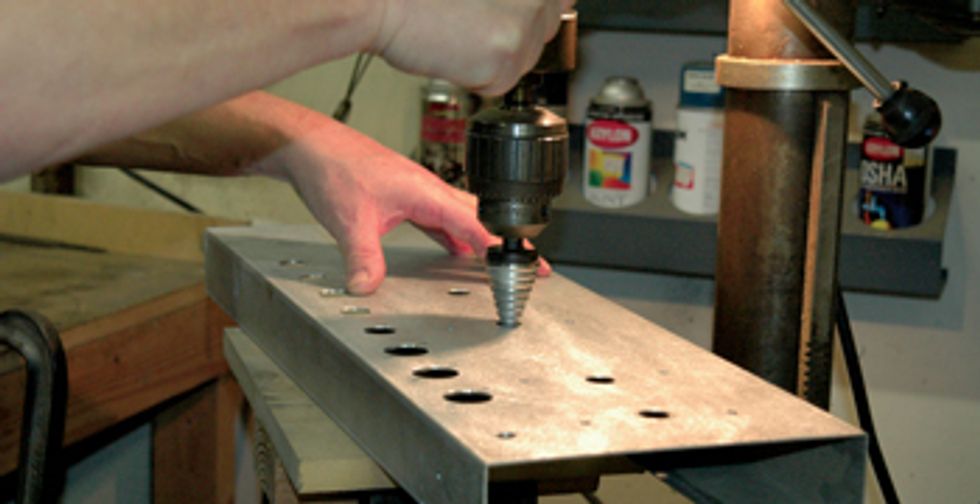
Zoom builds all of his amps by hand in his California workshop. Here he’s shown drilling holes in an amp chassis.
Do you use one when you play?
Yeah, not with X though—X just plays loud.
The room is my reverberation. When I play
rockabilly I use it, and when I do studio
work I always bring it. They’re small, they’re
light, they’re built like a tank—very durable.
Tell us about some of your clients.
I did all of Brian Setzer’s stuff for 18 years
until he moved to Minneapolis. And the guys
from the Black Crowes shoot me stuff. I’ve
worked with No Doubt, Jim Lauderdale,
Blind Lemon, Mike Ness, and I used to [build
stuff for] Dennis Danell when he was in Social
Distortion. I’ve done stuff for Jackson Browne,
Richard Gere, Bruce Willis, all kinds of people.
I was in Hollywood for 25 years.
I didn’t know Bruce Willis played guitar.
Bruce Willis had a band, he played harmonica,
and they used to tour around
Hollywood all the time. He had a bunch of
Fender tweed amps I used to fix, and I fixed
one of his harmonica mics.
Would you say the majority of your clients
are prominent musicians or do you
get amateur players as well?
Since I moved to Orange County I get a
mix. I still get people from all over the country—all over the world now—but it’s a mix.
So you work one-on-one with every client?
Yes.
How do you work with them to come
up with something that you can both be
proud of?
Well, sometimes they know what they want,
and sometimes they just want something. I
talk to them about what style they play and
who they like, what sound they like, what
records they like, where they play, and what
kind of situation they’re going to use it in.
And how long does it usually take to
complete one project?
To do a one-off? Probably 4 to 8 weeks—it
depends how complicated it is. Usually it
depends on how complicated the cabinetry
is, that takes the most time. The Cowboy
amp prototype I did for Gretsch took a lot
of time because of the wraparound grille
and all the asymmetrical parts.
And how did you get hooked up with
Gretsch in the first place? Was it just
because you played one of their guitars?
Yeah, well, because I was so strongly identified
with that one model, the Silver Jet, which
was a really unique guitar. They reissued them
so they don’t seem that unusual anymore,
but back in the ’70s and ’80s mine was the
only one people had ever seen and they
assumed that it was custom. The actual guitar
became sort of an icon. When Fender got
involved with Gretsch, [product manager] Joe
Carducci called me up and we started working
on the Billy Zoom tribute model.
When did you first start working on it?
I think 2007 was when they finally
started doing it seriously. I went out to the
Custom Shop a few times, and we took my
old ’55 Gretsch to a Kaiser Medical Center
to have it X-rayed and stuff, and they stuck
little mirrors up inside of it and measured
things, and then they made a couple prototypes.
They sent me a prototype, then they
made a couple changes to it, and put it
into production.
So do you use one of the new ones or do
you use your original?
I tour usually with the first prototype.
I actually kind of like it. As I go to South
America and Europe, when I have to fly,
I usually take the standard production
model. The prototype is a one-off.
I don’t like to take one-of-a-kind things
on airplanes.
Then why was the original prototype
changed if you like it enough to tour
with it?
They over-relic’d the top on the first one.
The real ones don’t ever show wear on top.
I think they must have gotten that coating
from NASA.
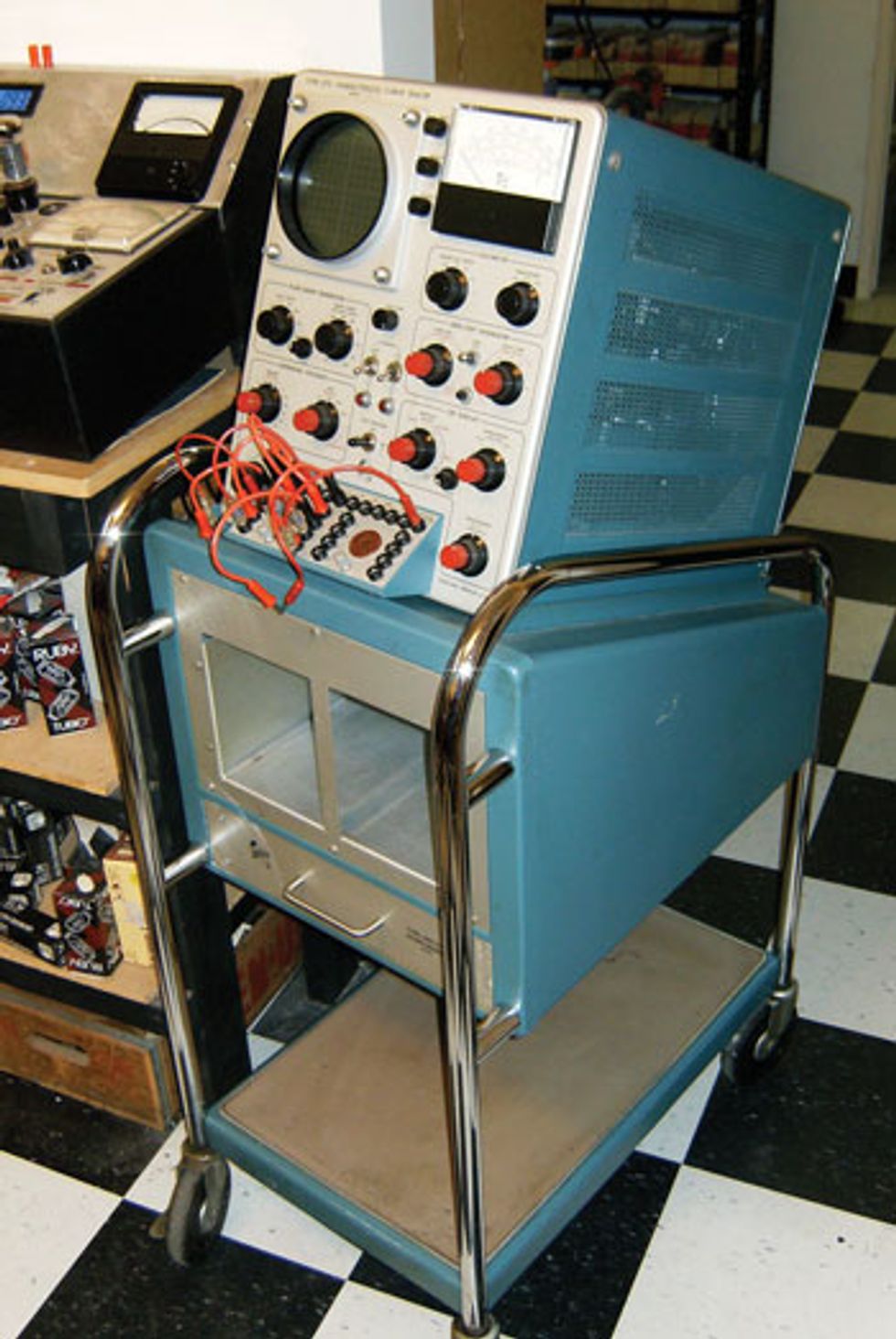
Zoom uses this Tektronix Model 570 to match tubes and compare modern valves to their original specs. “It’s an extremely rare piece,” he says. “Mine came from an electronics school in Minnesota.”
Are you still using the amp you made for
yourself in the ’80s?
Yep. Same amp since ’84. Never a problem.
I changed the tubes once in 2005. My plan
was to make an amp that didn’t break on
tour. It has two 4x12 cabinets and I’ve got
two output sections. I’ve got four 6L6s in
it and you switch back and forth, so in the
event that one ever fails you just switch to
the other output section.
How do you start a project like that?
I started it the way I start every project. I
sit down with a piece of graph paper and
a pencil, and I just kind of stare off into
space and start thinking about circuits.
Then I play with it until it looks right,
and then I go to the shop and I build
what I drew.
What are you doing right now?
Right now I’m looking at a prototype I
made for Gretsch that so far hasn’t made
it into production. It’s a Cowboy amp.
I took the essence of the cowboy-style
amp [that was popular in] the ’50s and
early ’60s and put it on a modern amp.
It’s got the tooled leather binding and
wraparound grille with the steer head on
it and has the reverb and tremolo circuits
from the Kahuna built into it. It’s got
a modified Baxendale EQ and a single
12—it’s 20 watts.
There’s another one that I designed for Gretsch which has active EQ with just a volume control and a single tone control, but the tone control is a two-legged LC circuit, so when you turn the knob, it moves the boost frequency up or down, which gives it a fantastic range of tonal quality. It’s 18 watts with a single 12. And then I’ve got a little 4-watt studio amp, it’s really good for recording. It has gain, master, treble, and bass controls. It’s been very popular with session musicians and studio owners. I can also add a secondary design called a multiwatt to any tube amp—there’s a switch on the back that will vary the actual wattage. I came up with that about 25 years ago. I’ve done probably hundreds of them—it’s a very popular mod.
Have you noticed any trends lately in
terms of what amps players are using?
A lot of people just want something
small that they can play at home—something
they can play in the living room
without deafening everybody.
Are you still innovating with different
mods?
Oh yeah. I’m just building on a new
one now. It’s nothing fancy, just a mod a
guy’s been asking for.
What was he looking for?
I don’t think he knew, so I just made
something I thought he’d like. My goal was to make it sound full and punchy without
having to put any holes in it because
it’s a mid-’60s Bandmaster. I didn’t want
to do anything that couldn’t be removed
completely in about 20 minutes. I wanted
to make an extra gain stage without making
any holes.
What’s special about your designs?
They sound fantastic. They’re almost
unbreakable. One of the ways I like to
challenge myself is using fewer parts than
anybody else uses and making something
that works better. It’s all my own design,
they all have unique circuits, they’re not
really like anything else. They all have
their own unique sounds, and they’re all
different.
How has West Coast culture influenced
your career and ambitions?
I’ve been out here since the ’60s. I don’t
really know what it’s like to live anywhere
else. I like the West Coast. We’ve got mountains and oceans, winding roads
for sports cars, and anything I want I can
get—I can buy, or have it made, within six
blocks of my shop. My shop is kind of like
having my own amusement park. I’ve got
everything I like. My electronics shop has an
amazing assortment of esoteric test gear. I’ve
got two Tektronix tube curve tracers, and
all kinds of laboratory instrumentation, and
then in the back I have a full metal shop so
I can do machining or sheet metal work,
and next to that I have a full wood shop so
I can build cabinets in the back. I also have
a restoration shop, and on the other side of
the wall I have a state-of-the-art recording
studio and a tracking room there. Of course,
it’s all soundproof—it’s a good place to try
out things. If someone wants to try out an
amp, they can go in there and they won’t
bother anybody. I probably wouldn’t leave if
I didn’t have kids.
How old are your kids?
I have 6-year-old twins. A boy and a girl.
Are they going to be musicians?
Gosh, I hope not. I would hope I raised
them better than that. Sometimes they take
instruments from the studio that they want
to play with, but they’re just getting to the
point where they won’t break it faster than I
can tell them not to.
But you have a repair shop.
Yes. I’m still doing repair when I can.
This year it’s been hard for people to
catch me since I’ve been out touring so
much. I closed for a couple months to
move the shop into a bigger unit. It was
just this big, empty, dirty space and we
had to tear a couple walls down, clean the
whole place out, paint it, and do a couple
of walls … so I’ve been kind of hard to
catch. Hopefully I’ll be able to do more
this year.
How do people generally hear about
your business?
I think word of mouth. I’ve been doing it
for so long on the West Coast that pretty
much everyone knows who I am—plus
I’m the guy from X. I’m often out on tour,
which is the only problem, as far as them
getting hold of me.
So does being Billy Zoom help or hinder
your business in the end?
I’m not sure it does either. I was doing it a
long time before there was X. And, then I
was Billy Zoom, but I don’t think it carried
much weight. It’s worked out well for me.
Many people have called you an icon.
How do you relate to that?
I think it’s great. They could call me a lot
worse things. I’ll accept it.
What’s on the immediate horizon for
your amp shop?
I’m still kind of putting things away from
after the move. I’ll be around more in the
coming year than I have been. People can
come into the shop. In the tracking room
of my studio I usually have the Cowboy,
the blue one, the little 4-watt one, and my
X amp, and my old Bassman head has a
bunch of my mods on it so people can try
it and see what I can do.
In the Shop with Mr. Zoom
The time that Billy Zoom puts into handwiring designs he says are “almost unbreakable” is what requires him to make gear in limited-production runs. As he works on custom builds and repairs in his shop, Zoom keeps his original amps with signature mods (including the wattage-varying “multiwatt” mod he came up with 25 years ago) on hand to show customers what he can do. Here’s a look at three of his main creations.
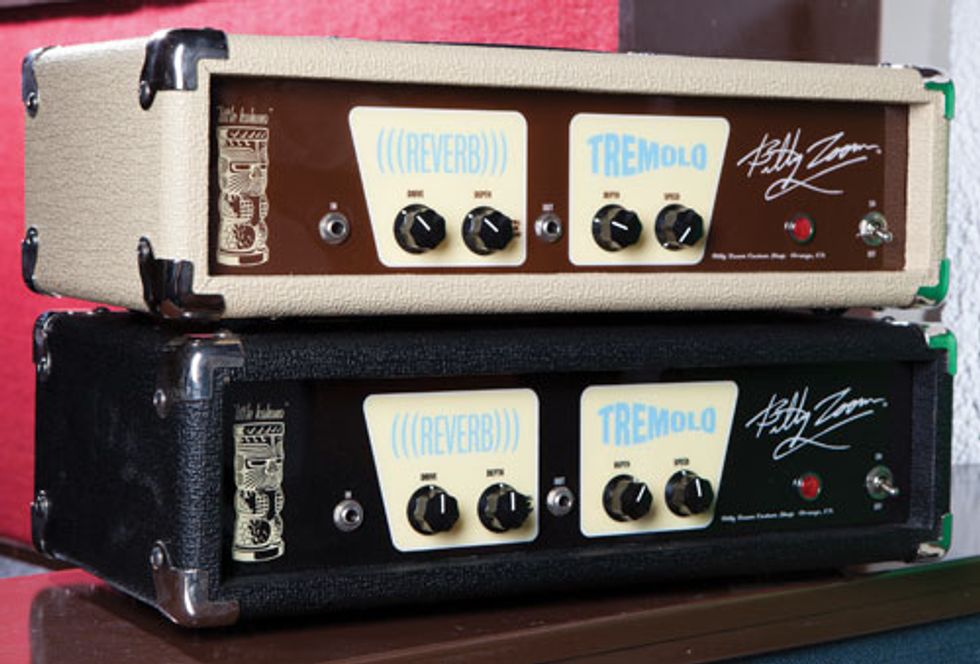
Little Kahuna
The Little Kahuna is an all-tube,
high-end reverb and tremolo
housed in one unit. These
tone machines use one 6BM8
tube and two 12AX7s, with
dual footswitching for silent
movement between effects.
The cabinets are dovetailed
7-ply Baltic birch covered in
heavy NubTex that’s available
in blonde, black, brown, or
tweed. This is Zoom’s only current
model in serial-numbered
production, with the number
made around 70.
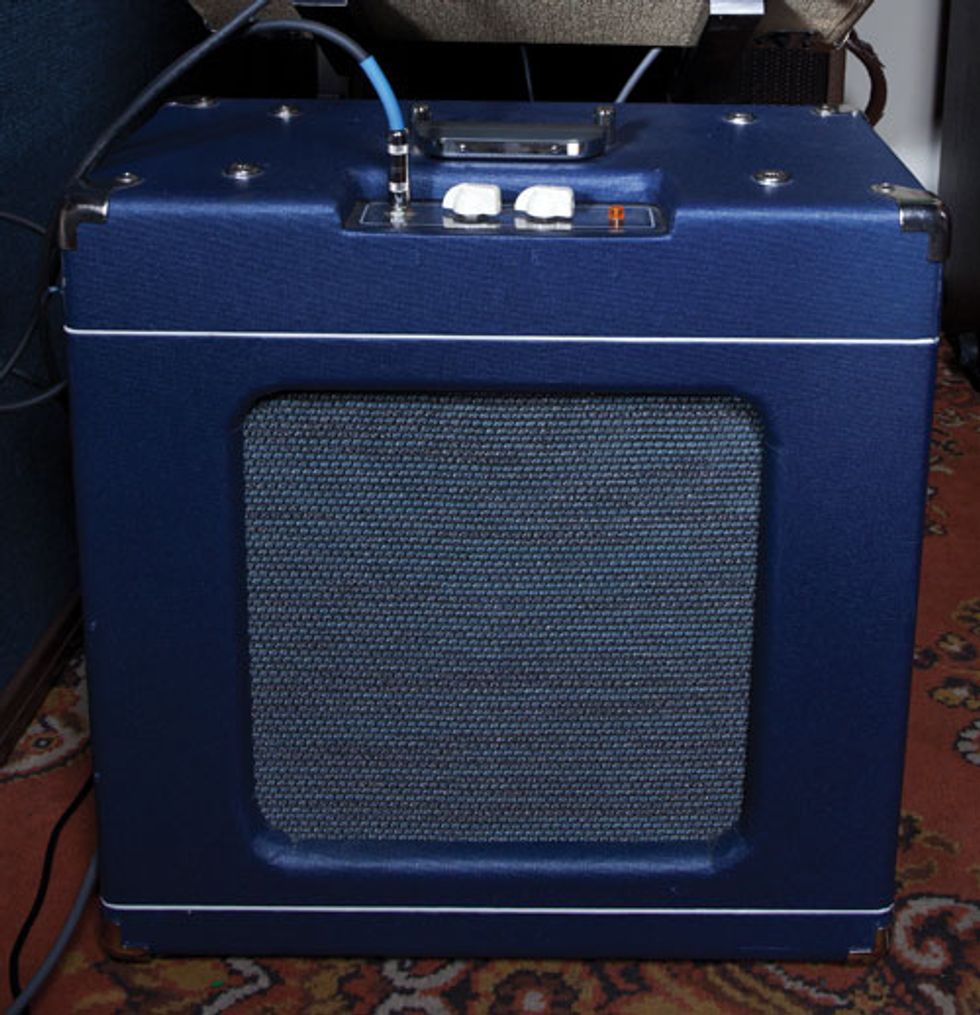
Cowboy Amp
Zoom’s 20-watt Cowboy amp
was built originally as a prototype
for Gretsch. He plans to
start production of this amp
and his “Little Blue Killer” (see
below) later this year, starting
with runs of 50 amps per
model. This design has the essence
of cowboy-style amps
from the ’50s and early ’60s,
including tooled-leather binding,
wraparound grille, and a
steer-head logo. It also has
the reverb and tremolo circuits
from the Little Kahuna, as well
as a modified Baxendale EQ.
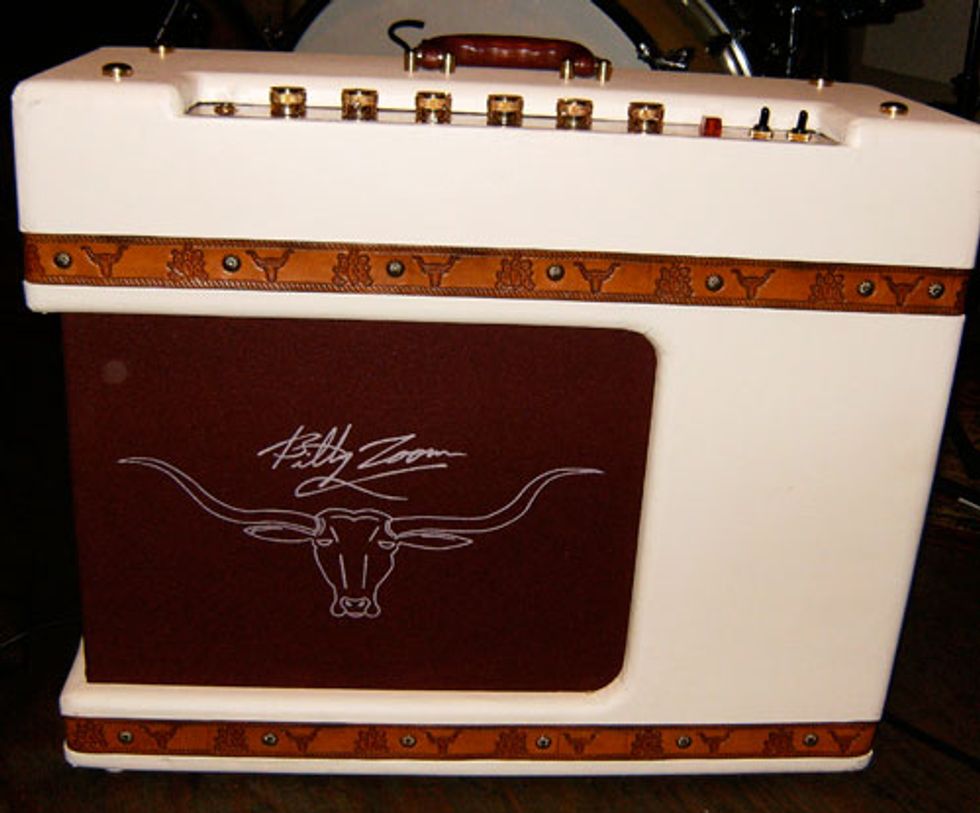
The Little Blue Killer
This 18-watt amp (also
designed for Gretsch) uses
EL84 power tubes and has
just a volume control and a
single, active tone control.
“When you turn the knob, it
moves the boost frequency
up or down, which gives it a
fantastic range,” Zoom says.
Photos by John Gilhooley







![Rig Rundown: Russian Circles’ Mike Sullivan [2025]](https://www.premierguitar.com/media-library/youtube.jpg?id=62303631&width=1245&height=700&quality=70&coordinates=0%2C0%2C0%2C0)

















